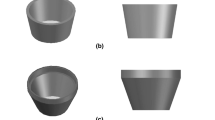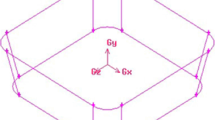Abstract
As the Zizania latifolia has a delicious taste, high nutritional value and rich moisture, it is easy to rot and deteriorate due to the high moisture content, resulting in short shelf life. In order to maintain quality of Zizania latifolia, the vacuum cooling process of cylindrical vegetables is experimentally studied. Considering the transient heat transfer and mass conservation, a mathematical model of heat and mass transfer in the vacuum cooling process of cylindrical vegetables is established. Meanwhile, the temporal trends of total system pressure, temperature distribution, evaporation rate of water, weight loss and moisture content of Zizania latifolia are simulated by CFD software. The experimental data are compared with the CFD simulation results. It is found that the differences of the temperature between the simulation and the experiments are 4.7%. The amount of water evaporated from the Zizania latifolia by simulation is 5.5% during the whole vacuum cooling, while the tested water loss rate is 9.8%, the maximal deviation of weight loss is within 4%. The simulated result of 83.5% after a cooling time of 850 s, gives a reasonable agreement with the experimential moisture content of 86.7% in the same cooling period. The results show that the CFD simulation values agreed well with the experimental data. It is significant for the study of the water transfer characteristics of cylindrical vegetables tissue and the optimization of the vacuum cooling process of the food industry.







Similar content being viewed by others
Abbreviations
- c p :
-
Specific heat (kJ kg−1 K−1)
- d a :
-
Diameter of pores (m)
- D :
-
Diameter of vegetables (m)
- f bh :
-
Respiratory heat of vegetables (kJ m−1 s−1)
- f v :
-
Rate of water vapor inside vegetables (kg m−1 s−1)
- h fg :
-
Latent heat of vaporization of water (kJ kg−1)
- h m :
-
Boiling coefficient of vegetables (= 8.4 × 10–7 kg Pa−1 m−2 s−1)
- i :
-
Time node
- m :
-
Space node
- \( {\overline{m}}_v \) :
-
Evaporation rate per unit volume of vegetables (kg m−3 s−1)
- M :
-
Molecular weight (kg kmol−1)
- n :
-
Normal of surface
- p :
-
Pressure (Pa)
- p s :
-
Saturation pressure (Pa)
- p v :
-
Pressure of vacuum chamber (Pa)
- q c :
-
Convective heat transfer (kJ m−1 s−1)
- q r :
-
Radiant heat (kJ m−1 s−1)
- r :
-
Cylindrical coordinate system
- R 0 :
-
Universal gas constant (=8.314 kJ kmol−1 K−1)
- S :
-
Speed of vacuum pump (m3 s−1)
- T :
-
Temperature (K)
- V :
-
Volume of vacuum chamber(m3)
- w as :
-
Weight percentage of ash (%)
- w ca :
-
Weight percentage of carbohydrate (%)
- w fa :
-
Weight percentage of fat (%)
- w pr :
-
Weight percentage of protein (%)
- w wa :
-
Weight percentage of moisture (%)
- x :
-
Cylindrical coordinate system
- ρ :
-
Vegetable density (kg m−3)
- μ :
-
Dynamic viscosity of water vapor (kPa s)
- ξ :
-
Migration resistance of water vapor
- Φ:
-
Internal heat source (kJ kg−1)
- θ :
-
Cylindrical coordinate system
- ε :
-
Porosity of vegetables
- λ :
-
Thermal conductivity (W m−1 K−1)
- κ :
-
Porosity of Zizania latifolia
- 0:
-
Initial
- a :
-
Average
- as :
-
Ash
- ca :
-
Carbohydrate
- fa :
-
Fat
- pr :
-
Protein
- wa :
-
Moisture
- v :
-
Vapour
References
McDonald K, Sun DW (2000) Vacuum cooling technology for the food processing industry: a review. J Food Eng 45(2):55–65
Tian D, Fen L, Jiangang L, Mengli K et al (2016) Comparison of different cooling methods for extending shelf life of postharvest broccoli. International Journal of Agricultural and Biological Engineering 9(6):178–185
Xu X, Zhang X, Liu S (2018) Experimental study on cold storage box with nanocomposite phase change material and vacuum insulation panel. Int J Energy Res 42(14):4429–4438
Xu X, Zhang X, Zhou S et al (2019) Experimental and application study of Na2SO4• 10H2O with additives for cold storage. J Therm Anal Calorim 136(2):505–512
Brosnan T, Sun DW (2003) Influence of modulated vacuum cooling on the cooling rate, mass loss and vase life of cut lily flowers. Biosyst Eng 86(1):45–49
Alibas I, Koksal N (2014) Forced-air, vacuum, and hydro precooling of cauliflower (Brassica oleracea L. var. botrytis cv. Freemont): part I. determination of precooling parameters. Food Science and Technology 34(4):730–737
Ozturk HM, Hepbasli A (2017) Experimental performance assessment of a vacuum cooling system through exergy analysis method. J Clean Prod 161:781–791
Ozturk HM, Ozturk HK, Kocar G (2011) Comparison of vacuum cooling with conventional cooling for purslane. Int J Food Eng 7(6):1–16
Cheng Q, Sun DW (2007) Effects of combined water cooking–vacuum cooling with water on processing time, mass loss and quality of large pork ham. J Food Process Eng 30(1):51–73
Zhu Z, Li Y, Sun DW, Wang HW (2018) Developments of mathematical models for simulating vacuum cooling processes for food products–a review. Crit Rev Food Sci Nutr 14:1–13
Zhang Z, Drummond L, Sun DW (2013) Vacuum cooling in bulk of beef pieces of different sizes and shape–Evaluation and comparison to conventional cooling methods. J Food Eng 116(2):581–587
Sun DW, Zheng L (2006) Vacuum cooling technology for the agri-food industry: Past, present and future. J Food Eng 77(2):203–214
Campañone LA, Zaritzky NE (2010) Mathematical modeling and simulation of microwave thawing of large solid foods under different operating conditions. Food Bioprocess Technol 3(6):813–825
Azarpazhooh E, Ramaswamy HS (2012) Modeling and optimization of microwave osmotic dehydration of apple cylinders under continuous-flow spray mode processing conditions. Food Bioprocess Technol 5(5):1486–1501
Campañone LA, Paola CA, Mascheroni RH (2012) Modeling and simulation of microwave heating of foods under different process schedules. Food Bioprocess Technol 5(2):738–749
Torres SS, Jomaa W, Puiggali JR, Avramidis S (2011) Multiphysics modeling of vacuum drying of wood. Appl Math Model 35(10):5006–5016
Salehi F, Kashaninejad M (2018) Modeling of moisture loss kinetics and color changes in the surface of lemon slice during the combined infrared-vacuum drying. Information Processing in Agriculture 5(4):516–523
Jin TX, Zhang HC, Li GL, Chen HX (2008) Theoretic analysis and experimental study on the mechanism of moisturemovement during vacuum cooling of cooked meat. Transactions of the Chinese Society of Agricultural Engineering 24(8):309–312
Bahrani SA, Monteau JY, Rezzoug SA et al (2014) Physics-based modeling of simultaneous heat and mass transfer intensification during vacuum steaming processes of starchy material. Chem Eng Process Process Intensif 85:216–226
Sun DW, Hu Z (2003) CFD simulation of coupled heat and mass transfer through porous foods during vacuum cooling process. Int J Refrig 26(1):19–27
Drummond L, Sun DW (2012) Evaluation of the immersion vacuum cooling of cooked beef joints—mathematical simulation of variations in beef size and porosity and pressure reduction rates. Innovative Food Sci Emerg Technol 16:205–210
Wang C, Xu R, Song Y, Jiang P (2017) Study on water droplet flash evaporation in vacuum spray cooling. Int J Heat Mass Transf 112:279–288
Kan AK, Han HD (2010) Mathematical heat and mass transfer model and experimentof column vegetable vacuum cooling before reefer container transportation. Journal of Shanghai Maritime University 31(3):58–62
Dostal M, Petera K (2004) Vacuum cooling of liquids: mathematical model. J Food Eng 61(4):533–539
He Z, Qian J, Qu L et al (2019) Simulation of moisture transfer during wood vacuum drying. Results in Physics 12:1299–1303
Demarchi SM, Irigoyen RMT, Giner SA (2018) Vacuum drying of rosehip leathers: Modelling of coupled moisture content and temperature curves as a function of time with simultaneous time-varying ascorbic acid retention. J Food Eng 233:9–16
Song XY, Liu BL, Jaganathan GK (2016) Mathematical simulation on the surface temperature variation of fresh-cut leafy vegetable during vacuum cooling. Int J Refrig 65:228–237
Yan J, Hu Z, Wu P et al (2017) Optimization of hot-plate and microwave combined vacuum freeze drying process of water-oat. Transactions of the Chinese Society of Agricultural Engineering 33(1):262–270
Zhang M, Zhong ZY, Yang L et al (2011) Affecting factors of heat capacity of fruits and vegetables. Food Sci 32(11):9–13
Augusto CM, Ribeiro JB, Gaspar AR et al (2012) A mathematical model describing the two stages of low-pressure-vaporization of free water. J Food Eng 112(4):274–281
Rao MA, Rizvi SS, Datta AK, Ahmed J (2014) Engineering properties of foods. CRC Press, New York
Talukdar P, Steven M, Issendorff FV, Trimis D (2005) Finite volume method in 3-D curvilinear coordinates with multiblocking procedure for radiative transport problems. Int J Heat Mass Transf 48(21–22):4657–4666
He SY, Li YF (2008) Experimental study and process parameters analysis on the vacuum cooling of iceberg lettuce. Energy Convers Manag 49(10):2720–2726
Arashisar Ş, Hisar O, Kaya M, Yanik T (2004) Effects of modified atmosphere and vacuum packaging on microbiological and chemical properties of rainbow trout (Oncorynchus mykiss) fillets. Int J Food Microbiol 97(2):209–214
Zhu ZW, Geng Y, Sun DW (2019) Effects of operation processes and conditions on enhancing performances of vacuum cooling of foods: A review. Trends Food Sci Technol 85:67–77
Acknowledgements
This work is financially supported by the Natural Science Foundation of Shanghai under Grant No.15ZR1419900.
Author information
Authors and Affiliations
Corresponding author
Additional information
Publisher’s note
Springer Nature remains neutral with regard to jurisdictional claims in published maps and institutional affiliations.
Rights and permissions
About this article
Cite this article
Wang, N., Kan, A., Huang, Z. et al. CFD simulation of heat and mass transfer through cylindrical Zizania latifolia during vacuum cooling. Heat Mass Transfer 56, 627–637 (2020). https://doi.org/10.1007/s00231-019-02736-5
Received:
Accepted:
Published:
Issue Date:
DOI: https://doi.org/10.1007/s00231-019-02736-5




